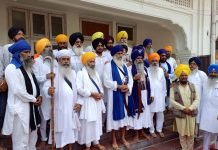


Year after year, in the first week of June, the faithful gather in major cities around the world—London, New York, Toronto, Vancouver, San Francisco. They remember the tens of thousands of Sikhs who died in June 1984. They remember the hundreds of thousands that died in the ensuing decade of genocide—the deliberate, orchestrated attack to destroy the very hearts and minds of the Sikh peoples.
First week of June marks the terrible attack on Sachkhand Sri Darbar Sahib, aka The Golden Temple—the Sikhs’ holiest shrine—wherein the Indian government lined up pilgrims on a holy day and shot them in cold blood. A day when the holy pool of nectar flowed red with the blood of the innocent.
While the purpose for many at the rallies this past week was to remember those who died and create awareness of the atrocities committed by the Indian Government, those who lived through it continued the cries of “Khalistan Zindabad”—”Long Live Khalistan”.
Looking back to the larger than life hero cum martyr portrayed by Sant Jarnail Singh Bhindranwale, we see that he never asked for Khalistan. This humble saint had a vision and a purpose: Sikhs should be free in a democratic and secular India. Sikhs should have the same basic human rights promised them by Gandhi and the British at partition. Sikhs should be able to live in peace without fear of Government retribution.
If Sikhs were given a separate homeland, he wouldn’t have turned it down; but that wasn’t his purpose.
If it weren’t for the unwarranted attack on Sikh shrines across India in June 1984, and the subsequent decision to wipe out all religious Sikhs—to the point where nobody who remembers and had a choice is currently living in India, whether by death or displacement—Sikhs today would not be crying out for Khalistan. The 1986 resolution by the democratic body of the Khalsa—the Sikh Nation—would not have asked for an independent Punjab free from the tyranny of the majority. Operation Black Thunder, in 1988, attacking the same holy shrine again to try and silence remaining Sikhs, would not have happened.
But the tragedies did occur. India has yet to apologize or prosecute any criminals. Sikhs continue to be oppressed. The Indian government tactics have changed to those of subversion—piping in drugs and alcohol, taking over Sikh institutions, creating fake saints and cults, subverting basic Sikh principles and morality, prosecuting Sikhs who proselytize under false cases.
Sikhs have known for years that Sikhism cannot flourish freely in today’s India—thus the calls for Khalistan. The will of Sikhs to fight and die for Khalistan has waned and India is not about to hand over its breadbasket to a minority it has worked so hard to destroy. Given this fact, are the cries of “Khalistan Zindabad” on the other side of the globe set to accomplish anything in today’s climate?
Perhaps its time for a new tactic. Sikh organizations around the world have already begun legal cases in country after country against India’s elite criminal politicians with blood on their hands. Videos have been made documenting case after case of human rights abuses. Pictures and documents are surfacing and being made public, implicating criminals in genocide. Witnesses who fled India, scared for their lives, have begun to speak up from the safety of their homes in the west.
But is it far enough?
When the then King of Italy stole the Vatican controlled lands and formed the Kingdom of Italy, the Catholic Pope retreated to the Vatican City walls, refusing to surrender, creating an unofficial state of Vatican within the Italian capital of Rome. This city state became official in 1929, making the Pope the King of the country of Vatican.
Is it time for the Sikhs to create a city-state for the Darbar Sahib complex? Would this allow the Sikh people to progress globally without the unwarranted hindrance of the Indian-Aryan supremacists? Would this quiet down the so-called “separatists” around the world who watched their homes burn, their sisters raped, and their families murdered?
Perhaps the state of “Sachkhand”, with no inhabiting citizens, as a sovereign homeland of the Sikh people, could serve as a capital for Sikhs around the world—free from corruption and meddling by Indian officials. The loss of this small piece of land (0.2 sq km in total) would go a long way in healing Indo-Sikh relations, and yet be negligible to the Indian state.
So is it time to begin the process of fighting for a free Akal Takht, a free Darbar Sahib complex, and a free state of “Sachkhand”?
Editor’s Note: What do you feel about this proposal? Do you feel such a goal would be against the dreams of the Sikh shaheeds? Please email us your views!





The Stateof Sikhs(Maharaja Ranjit SIngh) to the State of Sikhs(after 1947) and now as you Propose-The State of Sikhs(State of Sachkhand). Seems like loosing a lot instead of asking for what has already been taken away.
Just preserve the History and time will pay back.
This isn’t losing anything–we have nothing to lose! Look at it as a way of gaining ground in a way that all sides can easily agree on.
Even if there is a free Khalistan one day, perhaps having an independent Akal Takht which is not beholden to any politicians or countries is a good thing.